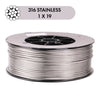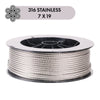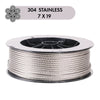Deciding Between Stainless Steel Cable: 304 vs. 316 Explained
When you're in the market for stainless steel cables, you'll often come across 304 and 316 stainless steel options. But what's the difference, and why does it matter? Let's dive into the details to help you make an informed choice and find the right stainless steel cable for your needs.
Composition and Corrosion Resistance
304 stainless steel, often referred to as 18-8, contains 18% chromium and 8% nickel. It's renowned for its excellent corrosion resistance and is commonly used in indoor and mild outdoor environments. This makes it the ideal choice for general applications where exposure to corrosive elements is minimal.
316 stainless steel, on the other hand, includes an addition of molybdenum (about 2-3%), which significantly enhances its resistance to chlorides and other industrial solvents. This makes 316 stainless steel the preferred option for marine environments or applications where the cable will be exposed to saltwater or harsh chemicals.
Strength and Durability
Both 304 and 316 stainless steel cables offer impressive strength and durability. However, the presence of molybdenum in 316 stainless steel not only boosts its corrosion resistance but also improves its overall strength, especially in extreme conditions. This makes 316 stainless steel a better choice for demanding applications.
Cost Considerations
Due to its enhanced properties, 316 stainless steel is generally more expensive than 304 stainless steel. If your application involves harsh environments or exposure to corrosive elements, the extra investment in 316 stainless steel is worth it. For less demanding environments, 304 stainless steel provides a cost-effective yet robust solution.
Typical Applications
304 Stainless Steel
Perfect for indoor railings, general rigging, and architectural applications where the environment is relatively mild. Typical uses include:
- Indoor railings and handrails
- General rigging purposes
- Architectural frameworks
- Equipment where exposure to corrosive elements is minimal
316 Stainless Steel
Best for marine rigging, chemical plants, coastal installations, and areas with high exposure to chlorides. Typical uses include:
- Marine rigging and equipment exposed to saltwater
- Chemical processing plants
- Coastal installations
- Environments with high chloride exposure
Making the Right Choice
When choosing between 304 and 316 stainless steel cables, consider the specific needs of your project. If you're dealing with harsh environments, go for 316 stainless steel to ensure longevity and reliability. For general use, 304 stainless steel offers a great balance of performance and cost.
At E-Rigging, we offer a wide range of both 304 and 316 stainless steel cables from top brands like HAAS and Grand Strand, ensuring you get the quality and durability you need for your specific application. Browse our selection to find the perfect stainless steel cable for your project.
By understanding the differences between 304 and 316 stainless steel cables, you can make a more informed decision that ensures your application’s success and longevity. Happy rigging!





